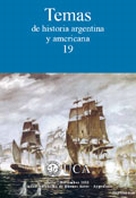Por favor, use este identificador para citar o enlazar este ítem:
https://repositorio.uca.edu.ar/handle/123456789/7271| Título: | Consideraciones sobre la educación media humanística bajo el primer peronismo (1946- 1955) : expansión de la matrícula secundaria, inversión estatal y orden educativo meritorio | Autor: | Cammarota, Adrián | Palabras clave: | EDUCACION SECUNDARIA; PERONISMO; ESTADO; CENTRALIZACION | Fecha de publicación: | 2011 | Editorial: | Pontificia Universidad Católica Argentina. Facultad de Ciencias Sociales, Políticas y de la Comunicación. Instituto de Historia Argentina y Americana | Cita: | Cammarota, A. Consideraciones sobre la educación media humanística bajo el primer peronismo (1946-1955) : expansión de la matrícula secundaria, inversión estatal y orden educativo meritorio [en línea]. Temas de historia argentina y americana. 2011, 19. Disponible en: https://repositorio.uca.edu.ar/handle/123456789/7271 | Resumen: | Resumen: El artículo analiza la expansión de la educación pública en el ciclo secundario bajo el primer peronismo, los intentos de centralización educativa y la fundación de los Colegios Nacionales a lo largo del territorio nacional junto con la estructuración de un sistema de enseñanza “meritorio”, basado en la obtención de “calificaciones suficientes” y cuyos merecedores estaban en condiciones de alcanzar los “más altos grados de instrucción”. Estos mecanismos habrían funcionado como una barrera de contención para evitar la afluencia masiva de miles de jóvenes que aspiraban continuar sus estudios secundarios y universitarios, pautando una suerte de contradicción con la “lógica de la justicia social”. Sin caer en la especificidad, se señala un estudio de caso – la fundación del Colegio Nacional Mixto de Morón en el año 1949- con el fin de visualizar los posibles mecanismos políticos que primaron entre las provincias y la repartición central a la hora de desviar los recursos necesarios para la radicación de instituciones educativas. Abstract: This article examines the expansion of public education at the secondary level under the first Peronist, attempts to centralize education and the founding of the National Schools throughout the territory and by structuring an education system “merit” based in obtaining “sufficient qualifications and merit which were able to achieve the” highest levels of instruction. “These mechanisms would have worked as a containment barrier to prevent the influx of thousands of young people who aspired to continue their high school and college, locking a sort of contradiction with the “logic of social justice. Without falling into the specificity, and presents a case study - the foundation of the National Joint College of Moron in 1949 - in order to visualize the possible policy mechanisms that prevailed among the provinces and the central distribution when diverting resources needed for the establishment of educational institutions. |
Cobertura Espacial: | ARGENTINA | URI: | https://repositorio.uca.edu.ar/handle/123456789/7271 | ISSN: | 0328-0284 2469-0961 (online) |
Disciplina: | HISTORIA | Derechos: | Acceso Abierto | Fuente: | Temas de historia argentina y americana. 2011, 19 |
| Aparece en las colecciones: | TEM - 2011 nro. 19 |
Ficheros en este ítem:
| Fichero | Descripción | Tamaño | Formato | |
|---|---|---|---|---|
| consideraciones-educacion-media-humanistica.pdf | 556,62 kB | Adobe PDF |  Visualizar/Abrir |
Visualizaciones de página(s)
303
comprobado en 30-abr-2024
Descarga(s)
162
comprobado en 30-abr-2024
Google ScholarTM
Ver en Google Scholar
Este ítem está sujeto a una Licencia Creative Commons

